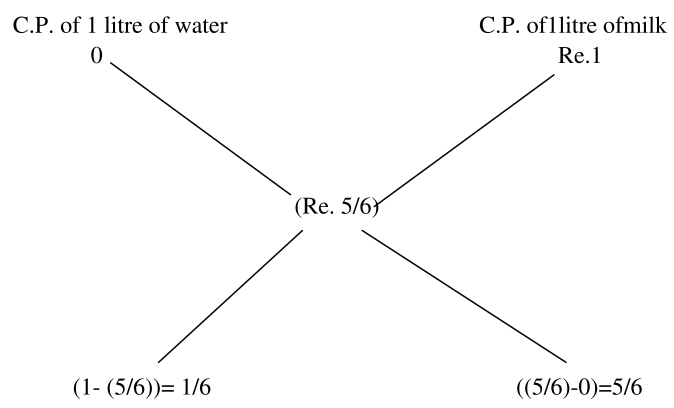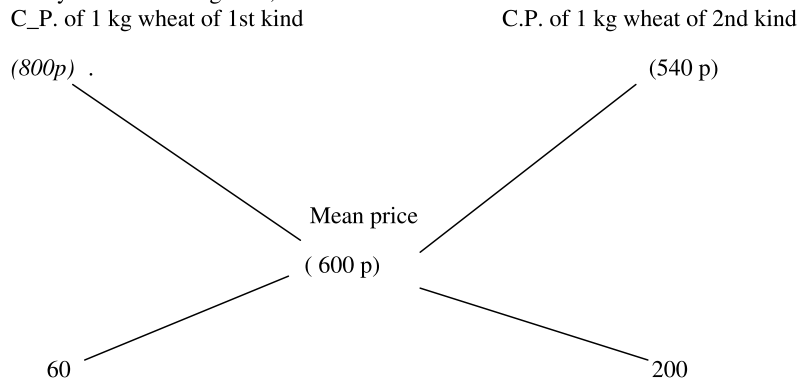-
ALLIGATIONS
If \( A_1, A_2, A_3, ..., A_n \) are the groups of people with total members \( n_1, n_2, .. ,n_n \)
Then the weighted average is given by \( \frac{n_1*A_1 + n_2*A_2 + ... + n_n*A_n}{n_1 + n_2 + .. + n_n} \)
Assume two groups are there we can rewrite average as Aw = \( \frac{n_1A_1 * n_2*A_2}{n_1*n_2} \)
We rewrite the equation as : (\( n_1 * n_2 \))Aw = \(n_1A_1 + n_2A_2\)
\( n_1(Aw - A_1) = n_2(A_2 - Aw)\)
or \( \frac{n_1}{n_2} = \frac{A_2 - Aw}{Aw - A_1}\). This is the Alligation equation.
The Alligation Situation
Two groups of elements are mixed together to form a third group containing the elements of both the groups
If the average of the first group is A1 and the number of elements is n1 and the average of the second group is A2 and the number of elements is n2 , then to find the average of the new group formed, we can use either the weighted average equation or the alligation equation.
As a convenient convention, we take A1 < A2 . Then, by the principal of averages, we get A1 < Aw < A2 .
Some Keys to spot A1, A2 and Aw and differentiate these from n1 and n2
Normally, there are 3 averages mentioned in the problem, while there are only 2 quantities. This isn’t foolproof though, since at times the question might confuse the student by giving 3 values for quantities representing n1 , n2 and n1 + n2 respectively
A1 , A2 and Aw are always rate units, while n1 and n2 are quantity units.
The denominator of the average unit corresponds to the quantity unit (i.e. unit for n1 and n2 ).
All percentage values represent the average values.
Solved Question Papers
Ans .
11.33
- Explanation :
1/2 = (12 – Aw)/(Aw – 10) Æ Aw – 10 = 24 – 2Aw fi 3Aw = 34 fi Aw = 11.33 `/kg
Ans .
3/2
- Explanation :
n1 /n2 = (40 – 34)/(34 – 30) = 6/4 = 3/2
Solved Question Papers
Case 1: A1, A2, Aw are known; may be one of n1 or n2 is known. To find : n1 : n2 and n2 if n1 is known OR n1 if n2 is known
Ans .
2 : 1
- Explanation :
Hence, solution is 2 : 1
Ans .
60
- Explanation :
If the ratio is 2 : 1 and the second class has 30 students, then the first class has 60 students
Ans .
5.66
- Explanation :
= (6 – Aw) : (Aw – 5) fi(6 – Aw)/(Aw – 5) = 4/8 So 12 – 2 Aw = Aw – 5 Illustration 5 Thus 3 Aw = 17 We get Aw = 5.66
Ans .
8.25
- Explanation :
= (x – 7) : 1 (x – 7)/1 = 5/4 Æ 4x – 28 = 5 x = 8.25
Ans .
2:1
- Explanation :
Hence, ratio is n1 = 40-30 and n2 = 30-25; ratio is 2 : 1, and the second class has 60 students
Ans .
60
- Explanation :
Hence, ratio is n1 = 40-30 and n2 = 30-25; ratio is 2 : 1, and the second class has 60 students
Ans .
5.66
- Explanation :
n1=4, n2=8, A1 = 5, A2 = 6. So by solving we get the required answer is 5.66
Ans .
26
- Explanation :
n1=40, n2=60, A1 = 20, A2 = 30. So by solving we get the required answer is 26
Ans .
26
- Explanation :
n1=40, n2=60, A1 = 20, A2 = 30. So by solving we get the required answer is 26
Ans .
4.625
- Explanation :
n1=3, n2=5, A1 = 4, A2 = 5. So by solving we get the required answer 4.625/kg
Ans .
60
- Explanation :
Mixing ` 4/kg and ` 5/kg to get ` 4.6 per kg we get that the ratio of mixing is 2:3. If the first oil is 40 kg, the second would be 60 kg
Ans .
4
- Explanation :
Since by selling at ` 4.40 we want a profit of 10%, it means that the average cost required is ` 4 per kg. Mixing sugar worth ` 3.6/kg and `4.2/kg to get ` 4/kg means a mixture ratio of 1:2. Thus, to 8 kg of the second variety we need to add 4 kg of the first variety to get the required cost price
Ans .
8.33
- Explanation :
In 125 gallons we have 25 gallons water and 100 gallons wine. To increase the percentage of water to 25%, we need to reduce the percentage of wine to 75%. This means that 100 gallons of wine = 75% of the new mixture. Thus the total mixture = 133.33 gallons. Thus, we need to mx 133.33 – 125 = 8.33 gallons of water in order to make the water equivalent to 25% of the mixture
Ans .
- Explanation :
The ratio of boys and girls appearing for the exam can be seen to be 3:1 as A1 = 60, A2 = 80 and Aw=65
Ans .
10320
- Explanation :
A1=560, A2=4000 and Aw=600 so solving we get it is clear that the ratio of the number of officers to the number of other employees would be 40:3400. Since there are 120 officers, there would be 3400 × 3 = 10200 workers in the company. Thus the total number of employees would be 10200 + 120 = 10320
Ans .
- Explanation :
Required ratio = 80 : 70 = 8 : 7. we get as A1 = 9.3 and Aw=10 and A2=10.8
Ans .
15
- Explanation :
C.P. of 1 litre of milk = Rs. (20 x 2/3) = Rs. 40/3. The C.P of 1 liter of water is Rs. 0. So we have A1 = 0, Aw = 10 2/3 i.e. 32/3 and A2 = 40/3. We now have to find out n1/n2. So solving by alligation method we get Ratio of water and milk = 8/3 : 32/3 = 8 : 32 = 1 : 4 Quantity of water to be added to 60 litres of milk = [1/4 X 60 ]litres = 15 litre
Ans .
1 : 5
- Explanation :
Let C.P. of milk be Re. 1 per litre. Then, S.P. of 1 litre of mixture = Re. 1. Gain obtained = 20%. C.P. of 1 litre of mixture = Rs.[(100/120)* 1] = Rs.5/6 By the rule of alligation, we have Ratio of water and milk = 1/6 : 5/6 = 1 : 5
Ratio of water and milk = 1/6 : 5/6 = 1 : 5
Ans .
10.8
- Explanation :
S.P. of 1 kg mixture = Rs. 7.20,Gain = 20%. So C.P. of 1 kg mixture = Rs.[(100/120)*7.20]=Rs. 6. By the rule of alligation, we have: Let x kg of wheat of 1st kind be mixed with 36 kg of wheat of 2nd kind.
Then, 3 : 10 = x : 36 or lOx = 3 * 36 or x = 10.8 kg.
Let x kg of wheat of 1st kind be mixed with 36 kg of wheat of 2nd kind.
Then, 3 : 10 = x : 36 or lOx = 3 * 36 or x = 10.8 kg.